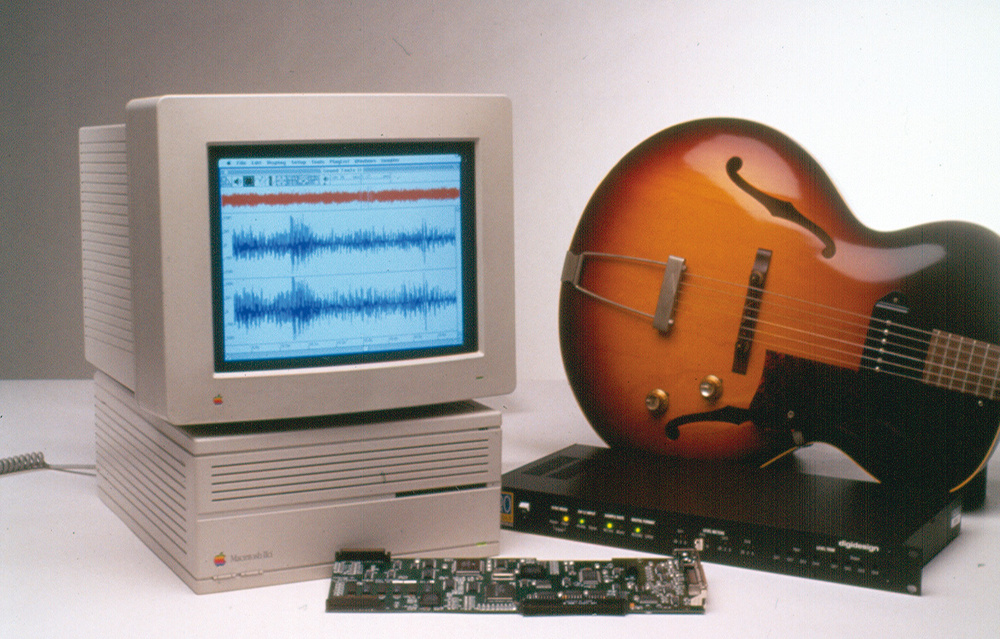Diving deep into the industry standard for most major recording studios and broadcast and post-production facilities on the planet
When stepping into the world of digital music production and recording, specifically when it comes to the Digital Audio Workstation (DAW), there is really only one program that is continually referred to and regarded as the industry standard – Pro Tools.
From humble (and by today’s standards primitive) beginnings, Pro Tools has grown through numerous iterations of itself, developing steadily into the gargantuan and colossally powerful DAW that it is today.
Pro Tools has found its home across a broad range of users, from music production novices right through to being the centrepiece of pretty much every major recording studio, broadcast, and post-production facility on the planet. This is not hyperbole either – simply do a quick Google search of the aforementioned, you’ll soon discover just how entrenched Pro Tools has become in both music production and broadcast, Pro Tools is the software that keeps these industries in motion, and none of this has happened by accident or from shrewd marketing schemes.
Birth of Pro Tools and Evolution
The 1980s were an interesting time for music and digital technology, even more so when these two disparate worlds started merging together. This was a time when analogue tape still reigned supreme in music recording, broadcast, and film, while digital technology was still very much in its infancy, a mere protozoan compared to the fully fledged animal it is today.
In tandem with the release of the E-mu Emulator II keyboard in 1984, friends and UC Berkeley graduates Evan Brooks and Peter Gotcher under the brand name Digidesign released Sound Designer – a sample editing system for the popular Emulator II keyboard. Sound Designer could be used on the first Apple Macintosh computer, also released in 1984. As the remainder of the ‘80s flew by and a wealth of computer technology developed, providing more connectivity and hard disk space, it wasn’t until 1989 that Digidesign created and released the first hardware and software package – Sound Tools.
Presented at the annual NAMM convention in 1989, Sound Tools was advertised as the “first tapeless studio”. The system’s Motorola 56001 processor allowed for 16-bit playback and recording sample rates of 44.1/48kHz through a two-channel A/D converter, pretty mind boggling for the time. As computer technology rapidly developed, so too did the development of multi-track sequencing, more complex audio streaming, and non-destructive editing.

Early on, Digidesign understood the importance of needing Pro Tools to have the capability to edit sound to video. Synchronising to external video and audio machines via SMPTE timecode was possible back in the early to mid 1990s, and into the late ‘90s and early 2000s, surround sound mixing was made possible, an essential for modern and film editing and mixing. This then expanded greatly into the numerous immersive formats, today being predominantly Dolby Atmos.
The first fully developed Digidesign release – Pro Tools II – merged the editor and mixer into one application and throughout the mid-‘90s (following the development of PCI versions Digidesigns Audiomedia, Sound Tools, and Pro Tools) could run on Windows for the first time. TDM architecture and plugins were then created, featuring a whopping 48 tracks of recording and playback and this time also gave way for the development of third party plugins to be used on the system. Also during this time Avid acquired Digidesign, with both companies growing at an accelerated rate.
In 1998 Pro Tools 24 MIX was released, allowing for a much larger 72 track count. With the level of DSP power available, for the first time, really powerful amounts of processing and in-the-box mixing was made a reality.
Ricky Martin’s ‘Livin’ la Vida Loca’ released in 1999 and was the first Billboard Hot 100 number one hit to be fully recorded, edited, and mixed on Pro Tools, and the rest as they say is history.
DAW for the modern era
Pro Tools in many ways mirrored the development of its analogue tape machine counterpart, having developed from a simple two-track recording system, quickly evolving into a multi-track recording and editing system.
The software and hardware elements evolved side by side in their capabilities into what we now know as the modern DAW, allowing for colossal simultaneous track counts (made possible with Pro Tools HDX, released in 2011), at next to zero latency with remarkable detail, sample-accurate precision, at incredibly high bit depths and sample rates. Things we very much take for granted now, particularly when performing simple recording, editing, and mixing tasks from a laptop at home.

Having made Pro Tools HD (otherwise known as Ultimate or most recently, Flex) native systems has allowed users to run Pro Tools HD without the need for Avid Pro Tools hardware. This has revolutionised the use of the fully fledged version of Pro Tools into the modern era, previously unavailable to those using non-Avid-based hardware. The standard version of Pro Tools (now dubbed Pro Tools Studio), as well as Pro Tools Artist and the free Pro Tools Intro have made this DAW available to all levels of music creators, engineers, and alike, without the hefty price tag and varying levels of slimmed-down features.
Streamlined workflow
Something that Avid (and previously Digidesign) seemed to have gotten right from the get go (and continues to improve upon) is the ability to understand the workflow requirements of recording and mix engineers, both within the music and broadcast industries respectively. The methodically engineered and logically laid out flow of running a Pro Tools session for either recording or mixing is still rather unmatched in its ability to categorise, organise, and lay out regions and clips for recording, editing, and mixing.
The seemingly simple yet wildly powerful playlist editing workflow allows recording multiple takes and overdubbing just stupidly easy, and comping performances together even easier. While some may argue that other DAWs are equally, if not more intuitive when it comes to capturing multiple takes, the logical layout, labelling, and colour coding of playlists within Pro Tools, to put it simply, just makes sense. And this can’t be understated when under the pressures of a fast-paced recording or mix session with artists in the room.
One thing the workflow of Pro Tools has been heavily based around is shortcuts and key commands. I mean there’s a dedicated colour coded, character filled keyboard for them for goodness sake! Sure, this isn’t exactly anything new or exciting at least by modern DAW standards, but it’s how these shortcuts integrate into the workflow that really makes them stand out. The aforementioned playlist editing is further enhanced by employing the use of a few simple shortcuts, making group and global-based editing of a session insanely quick and easy.
Where this becomes essential is when needing to make sessionwide or instrument group-based changes, such as altering an arrangement, and this can be done with a few simple key strokes, without needing to even think about grabbing the mouse or trackball. Watching a Pro Tools wizard in deep editing mode is exciting to even the most discerning DAW nerds.
Remaining current
In the most recent iterations of Pro Tools, Avid has also pioneered collaborative and cloud-based workflows in the DAW space with the Avid Cloud, which allows remote mix collaboration and flying sessions from one engineer to the next a breeze. This, along with a host of new folder routing and timecode display features, is just a further example of the continued evolution of the industry standard DAW for the modern engineer.
It’s easy to get carried away with the sheer amount of DAWs available today, and with that in mind it’s actually quite impressive that a program with such a long history is still keeping up with the demands of today’s music and broadcast productions. Both software and hardware integrations have remained at the peak of technological development within the industry and it’s with the company’s legacy and iconic history that it’s no surprise, Avid Pro Tools remains top dog.
Head to Avid to get started on your Pro Tools journey. For local enquiries, reach out to Innovative Music.






